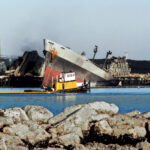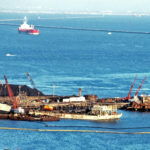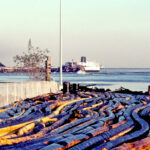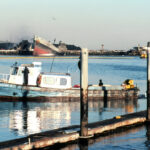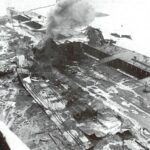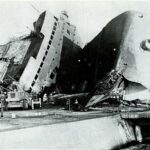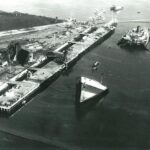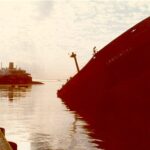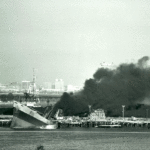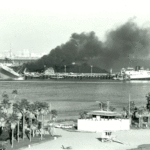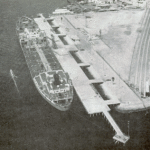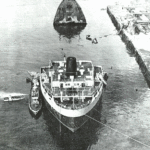The Sansinena Explosion: Raining Rivets
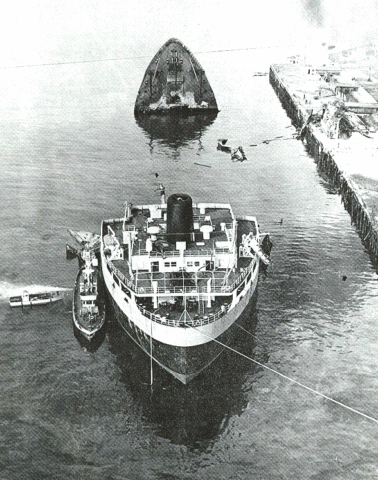
On December 17, 1976 the 810 foot long, 70,630 dwt oil tanker Sansinena (IMO: 5311650) exploded while berthed at the Union Oil Terminal in Los Angeles Harbor, California. The explosion and resulting fire would result in deadliest tanker disasters in the 1970s.
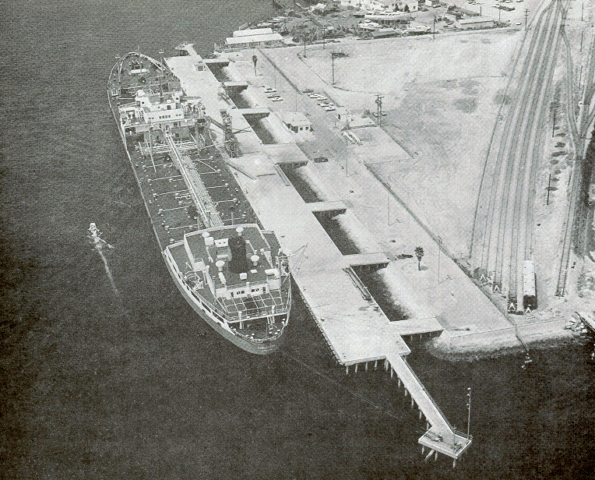
The Sansinena was a typical tanker built in 1958 at the Newport News Shipbuilding and Drydock Company in Newport News, Virginia. The tanker was 810 foot long, 104 foot wide and had a depth of 60 feet. It was propelled by a steam turbine with 25,000 horsepower. It had a raised forecastle, a midships block with an enclosed deck along with a deckhouse at the stern. The midship deck had five levels which included areas for storing cargo-handling equipment, staterooms for officers, battery room and radio room. On top of these areas was the pilothouse, chartroom and the flying bridge. The stern deckhouse is where the crew had their accommodations. The tanker had four lifeboats with two amidships and the remainder located aft.
The Sansinena was no stranger to trouble in the Los Angeles Harbor. On February 13, 1975 the Sansinena had entered the harbor loaded with 507,000 barrels of crude oil. With a pilot onboard, the vessel headed towards the Union Oil dock when it went aground and became stuck on a mud bank. Six tugs were dispatched and tried for several hours to free the tanker, but the Sansinena remained firmly stuck. The tanker Oregon Standard would later be brought alongside the Sansinena to lighter some 115,000 barrels of crude oil. The tanker would be refloated on the next high tide and proceed to the terminal. While no reports of damage or pollution released, there were questions why the vessel had gone aground. The Coast Guard had pointed out that visibility was good and the area has clearly marked on charts with a depth of 41 feet compared to the draft of the Sansinena was 47 feet. The cause of the stranding was never disclosed.
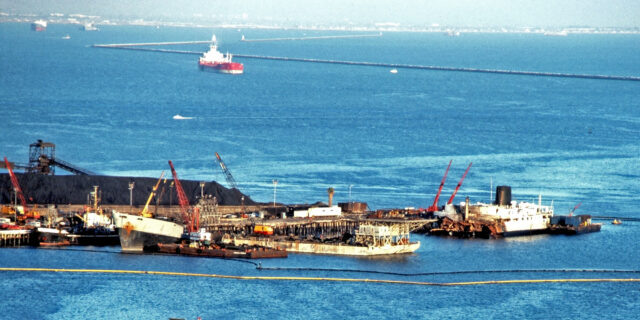
On the early morning of December 16, 1976, the Sansinena arrived at the Union Oil dock. The vessel wasted no time and begun discharging her tanks of crude oil. The cargo had been fully discharged by the early afternoon of December 17. During this time the weather was calm and visibility was good as terminal workers along with the crew on the Sansinena were engaged in their tasks. An inspector from the Los Angeles Fire Department came on board while the cargo was being discharged. The inspector determined there were no discrepancies and the tanker was up to code.
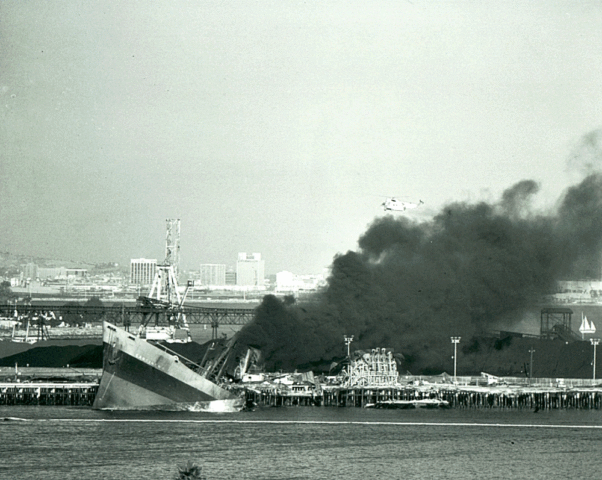
During the afternoon of December 17th, the crew began taking on water into its ballast tanks along with loading fuel oil into the after fuel tanks. The increase ballast would offset the empty product tanks giving the Sansinena additional stability and allow the vessel to sit lower in the water. At the same time, the crew were bunkering fuel oil on the tanker. Nearby to the terminal, there were workers doing some welding on a small boat only 200 yards away from the vessel. The welding continued until sunset before the work was stopped for the day.
While all the activity was going on, the vents were open on the product tanks. The vessel had five cargo tank venting systems which were opened as was the custom. These vents would remain open except when the ship was loaded with product. The vents were mounted on the deck and position both in the mid and aft sections of the vessel.
Around 7:30 pm, there were still several crew on deck engaged in loading fuel oil when there were two massive explosions erupting a wall of fire over the Sansinena. Witnesses state the first explosion was just aft of midships with a cloud of vapor or smoke before there was a larger explosion which broke the vessel apart. The midship deckhouse was blown some 750 feet into the air before it landed on the terminal. The rest of the vessel towards the bow was aflame as it settled into the water. The aft section was least damaged, but still was engulfed by flame and smoke. The crew who survived the blast were able to climb down a line from the stern section.
Unfortunately, the two crew who were on the deck at the time of the explosion were killed in the blast along with six other crew who were eating in the mess. A security guard on the dock was also killed in the blast. Many more people had been injured in the blast including 22 crew of the Sansinena and 36 others including some of the public who had been struck by shrapnel. Reports stated that multiple buildings nearby had been destroyed or had their windows blown out. Parts of the Sansinena hull was scattered across a wide area as if the area had been caught in a rainstorm of burning rivets.
The Lost Angeles Fire Department had a fireboat berthed nearby and was on scene within minutes. Additional fire fighters were requested as they got the fire under control. The fireboat was able to rescue 18 men who had jumped into the water to escape the flames. Fire fighters discovered that the shutoff valves for the oil had been destroyed as more than 500,000 gallons of crude spilt out. Thus the decision was made to allow the fire to burn out for four days before valves could be put in place. Eventually all fires were extinguished to allow salvage work.
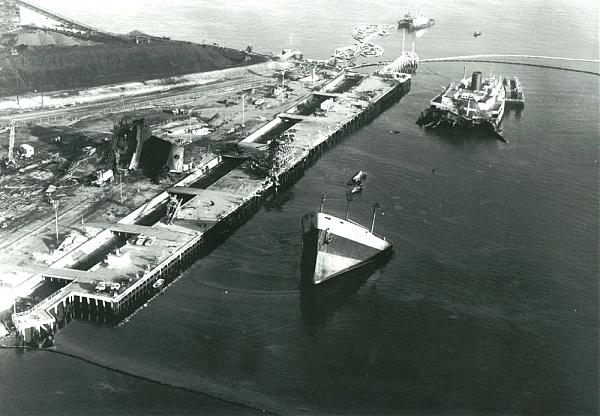
The Coast Guard along with local authorities placed booms around the vessel to contain the large amount of crude oil released into the harbor. Salvage workers removed the remains of the vessel which were taken away from the harbor to be scrapped. The Union Oil terminal was also determined to be too severely damaged and it was also removed. The total loss of the Sansinena along with the terminal amounted to a total loss of $21.6 million dollars. The tanker was owned by the Barracuda Tanker Corporation based in Bermuda and sailed under the Liberia flag at the time of the disaster.
The impact of the Sansinena explosion can be felt today. In 1978, United States Congress passed the Port and Tanker Safety Act (PTSA) added provisions that required regulations on personnel qualifications and standards for tankers vessels and on persons in charge of oil transfers.
